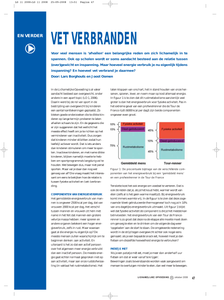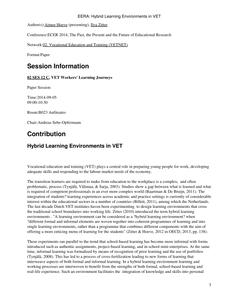Voor veel mensen is 'afvallen' een belangrijke reden om zich lichamelijk in te spannen. Ook op scholen wordt er soms aandacht besteed aan de relatie tussen (over)gewicht en inspanning. Maar hoeveel energie verbruik je nu eigenlijk tijdens inspanning? En hoeveel vet verbrand je daarmee?
DOCUMENT

Vocational education and training (VET) plays a central role in preparing young people for work, developing adequate skills and responding to the labour-market needs of the economy. The transition learners are required to make from education to the workplace is a complex, and often problematic, process (Tynjälä, Välimaa, & Sarja, 2003). Studies show a gap between what is learned and what is required of competent professionals in an ever more complex world (Baartman & De Bruijn, 2011). The integration of students? learning experiences across academic and practice settings is currently of considerable interest within the educational sectors in a number of countries (Billett, 2011), among which the Netherlands. The last decade Dutch VET institutes haven been experimenting to design learning environments that cross the traditional school boundaries into working life. Zitter (2010) introduced the term hybrid learning environments . "A learning environment can be considered as a hybrid learning environment? When different formal and informal elements are woven together into coherent programmes of learning and into single learning environments, rather than a programme that combines different components with the aim of offering a more enticing menu of learning for the students" (Zitter & Hoeve, 2012 in OECD, 2013, pp. 138).
DOCUMENT

This article proposes a model for the design of a hybrid VET curriculum across the school-work boundary.
LINK
This book is about markets for intermediate skills. It is also about the coordination within and between the (vocational) education system and the (sub-baccalaureate) labor market, and the institutions that govern them. Our goal was to improve our understanding of how particular governance regimes influence the operation of vocational education and training (VET) markets. We conducted an international comparison of three different governance regimes of VET markets in Germany, the Netherlands and the American state of Wisconsin. The central question underlying the national analyses and comparisons is: How do markets for intermediate skills operate in Germany, the Netherlands, and the American state of Wisconsin?
DOCUMENT

There are changes in society and labour market demands made to TVET and in the TVET system itself. To deal with both types of challenges, the aim for TVET planning and development is to anticipate how employment will evolve and to determine how to give individuals a knowledge base that will enable them to adapt to the changing demands and benefit from the mobility. Major research areas connected to relevant problem areas in the TVET planning and development process can be constituted by analysis of labour market developments and changes in learning contents, new insights into the development of skills, competences and expertise, integration of learning places in school and workplace, professional development of VET teachers and trainers and VET and organisational development in organisations.
DOCUMENT

The focus of the thesis is an exploration into students’ vocational knowledge in the context of Dutch vocational education and training (VET). The reason students’ vocational knowledge requires exploration is because there is no consensus among scholars in the field of VET about how to theorise the nature of students’ vocational knowledge; most (not all) scholars rely on dichotomous conceptualisations, such as theory versus practice, general versus specific or explicit versus implicit. However, such commonly used dichotomies are not very helpful to understand the complex nature of vocational knowledge. Vocational knowledge is more than putting bits of theoretical and practical knowledge together, it is characterised by sometimes-intimate relationships between knowledge and actions. As a result of the above-mentioned gap in the VET literature, there is little empirical research on how VET students develop vocational knowledge and the extent to which this is occupation-specific knowledge. To understand students’ vocational knowledge, four different aims are formulated and carried out in four studies. The aim of the first study is to identify powerful vocational learning environments to enable the selection of a case that represents high quality vocational learning and teaching. With an eye on analysing students’ vocational knowledge, the second study aims to conceptualise the nature of vocational knowledge that avoids dichotomies. Therefore, two conceptual frameworks are integrated; the idea of contextualising is introduced which is based on cultural-historical theory to highlight the crucial role activity plays in knowledge development and to understand the relationships between the mind (i.e., what people think (and feel)), and action (i.e., what people do). Secondly, the theory is supplemented with ideas from inferentialism, a philosophical semantic theory of meaning to provide a useful way to focus on students’ processes of knowing and to reveal students’ vocational knowledge in terms of ongoing reasoning processes. The third study uses the conceptualisation of vocational knowledge to explore how students develop vocational knowledge in occupational practice, and to illustrate the process of contextualising. The forth study aims to describe what characterises students’ vocational knowledge using an analytic framework that distinguishes between occupation-specific knowledge components and qualities. This thesis contributes to research scholarship in the field of VET and an understanding of students’ vocational knowledge in practice. The theoretical framework of contextualising supplemented with inferentialism provides an alternative way to focus on students’ processes of knowing and helps to reveal students’ vocational knowledge in terms of reasoning processes. The empirical explorations and illustrations of students’ vocational knowledge contribute to the scholarly literature and practice on understanding the nature of vocational knowledge, how students develop vocational knowledge and what characterises their vocational knowledge. The intention to introduce the idea of contextualising is not about reinventing the wheel but rather an attempt to understand how it turns and how it functions. The intention of this thesis is to encourage dialogue and move the debate about the nature of vocational knowledge further, and hence, to provide some “food for thought”.
DOCUMENT

Numeracy and mathematics education in vocational education is under pressure to keep up with the rapid changes in the workplace due to developments in workplace mathematics and the ubiquitous availability of technological tools. Vocational education is a large stream in education for 12- to 20-years-olds in the Netherlands and the numeracy and mathematics curriculum is on the brink of a reform. To assess what is known from research on numeracy in vocational education, we are in the process of conducting a systematic review of the international scientific literature of the past five years to get an overview of the recent developments and to answer research questions on the developments in vocational educational practices. The work is still in progress. We will present preliminary and global results. We see vocational education from the perspective of (young) adults learning mathematics.
LINK
Voor het eerst in de geschiedenis van de mensheid zijn er meer mensen met overgewicht dan met ondervoeding. Overgewicht is in snel tempo toegenomen en is een van de grootste maatschappelijke (gezondheids)problemen van deze tijd. Overgewicht heeft ondervoeding overschaduwd. In "The land of plenty"’ is geen gebrek meer, en dus geen ondervoeding zou je verwachten. Ondervoeding blijkt echter ook in deze tijd nog steeds een van de grootste maatschappelijke (gezondheids). Door inactiviteit of door ziekte kan spiermassa afnemen en wordt het steeds lastiger ondervoeding door de laag vet heen te ontdekken. Het aanpakken van overgewicht en ondervoeding door de professional vergt goed gewichtsmanagement. Voeding en beweging spelen hierbij een cruciale rol. Energie uit de voeding is gerelateerd aan vetmassa, en eiwit uit de voeding en beweging is gerelateerd aan spiermassa
DOCUMENT
The in-depth assessment of the situation of the European textile and clothing sector is composed by six independent reports with a close focus on key aspects useful to understand the dynamics and the development of the textile and clothing industry, drivers of change – most notably the impact of the financial crisis – and identification of policy responses and best practices. This has been done in six specific tasks leading to the six reports: Task 1 Survey on the situation of the EU textile and clothing sector Task 2 Report on research and development Task 3 Report on SME situation Task 4 Report on restructuring Task 5 Report on training and Education Task 6 Report on innovation practices This present report of task 5 provides an in-depth analysis of what has been done in terms of VET developments over the last decade in three key TC regions in Europe. It investigates industry ‘s attitudes and practices, education and training changes, and eventually tries to identify how mismatches between skills supply and demand have been addressed there and could possibly be addressed in the future in other regions of Europe.
MULTIFILE
